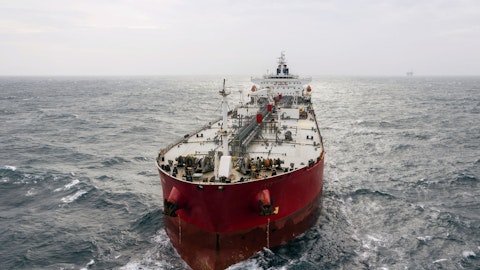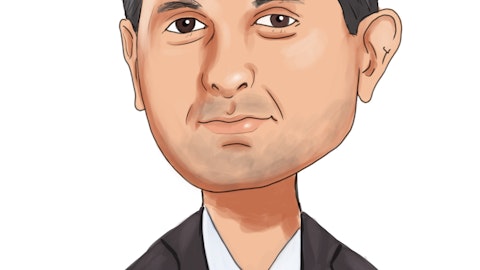Jon Chappell: Okay, I appreciate it. Thank you, Kevin. Thanks, Stewart.
Kevin Mackay: Thanks, Jon.
Stewart Andrade: Thanks, Jon.
Operator: Our next question coming from Omar Nokta with Jefferies. Your line is open.
Omar Nokta: Thank you. Hi, Kevin and Stewart. Good morning. Yes, just – yes, following up, I guess, on Jon’s line of questioning and also kind of basically the same topic that seems to come up each quarter is, yes, just indeed the – you know, the thought process or kind of what your strategic plans are longer term. I guess, you know, Kevin, you pretty much out – laid it out there that you’re comfortable, you’ve got the fleet you want. It’s generating a good amount of cash, especially in today’s market. But you don’t feel the pinch to go out and do anything in terms of acquiring assets. And then you mentioned if somebody were to present you with an offer on some ships, you’d be happy to entertain it if it was good enough. I guess, kind of in the bigger picture, grand scheme, when you think of, say, Teekay Tankers going forward, would you characterize it as perhaps maybe like a closed-end fund where you’re generating strong returns, you’re giving it – right now, you’re repaying down – you’re paying down debt and strengthening the balance sheet.
But do you see it evolving to where it just becomes a capital return story and then eventually selling the company altogether?
Kevin Mackay: I think the way we look at it, Omar, is, you know, we’ve put ourselves in a very good position. We have a fleet that is facing a very strong market, and we believe we’ve got the fleet that’s in the sweet spot in the tanker space, in that – the mid-size tankers. We’re benefiting from what is going on in the world right now and the durable ton-miles that have increased significantly. The industry’s fleet profile is aging. So, there is – and Teekay Tankers is no different in this. There is a need to do fleet renewal at some point. But we also feel that, you know, there’s no need to rush into that. We’ve got time. And yes, we can sell some of our older assets, and we may do so. But in the meantime, we want to try and maximize our exposure to the strength of this market and keep ships, you know, bringing in rates that we’re getting today at $70,000 a day.
That is adding shareholder value, in our view. So, in the future, we’ll deal with what comes our way. But for now, it’s really around maximizing the potential of the fleet we’ve got before we take any further steps to rejuvenate it.
Stewart Andrade: Maybe just following up on that a little bit, Omar, if we were viewing it as a closed-end fund, I think you’d see us being a significant dividend payer and distributing the capital that we’re generating. We’re not doing that. We’re holding on to the capital and creating capacity to be – to reinvest in the fleet. And that wasn’t in our prepared remarks this quarter, but certainly last quarter, that our focus is putting ourselves in a position to reinvest when the time is right and in an investment that we think will be accretive and add value for our shareholders.
Omar Nokta: Okay, thanks. Thanks, Stewart and Kevin. That’s helpful. I guess and – you know, you’ve been on this plan for perhaps maybe four years or five years where you really focused on deleveraging. You went from a very high leverage ratio to now, you know, net cash. And so, you’ve been playing the long game here. So, I guess, this is – basically what’s happened is you’ve taken advantage of a strong market to delever. You’ve gotten yourself in a great financial position. You’re now harvesting all the excess cash flow and just enjoying it, providing you tremendous flexibility. But in terms of, you know, looking to invest, basically you just need to wait for the – perhaps, I guess, the next part of the cycle, whether that takes two years or three years.
If we’re in this tanker market upswing that lasts into, say, ’25, ’26, can we just expect Teekay Tankers to just hang back, generate that cash flow, build up a nice cash cushion, and then once the cycle turns, that’s when you’re going to deploy capital in a different manner?


